The 2024 Trump "realignment" is already over
Claims of a conservative realignment of non-whites, the working class, and young voters have been highly exaggerated
It is a matter of fact that Donald Trump won the 2024 election in large part by shrinking the vote margins for Kamala Harris among non-white, working-class, and young voters, relative to past Democratic nominees.
But the interpretation of Trump’s 2024 win is a matter of opinion. Some, like the Republican pollster Patrick Ruffini, have argued Trump’s inroads with traditionally left-leaning voters represented a fundamental realignment in American politics. He is not alone in arguing this. Many in the Democratic Party, too, interpreted Trump’s 2024 win as a historic blow — the performance of a coalition on life support. On marches the emerging Republican majority. Left-liberalism is dead.
Other analysts have been more skeptical. On the subject of realignment, political scientists have tended to land on the answer “it’s complicated.” For one thing, they argue, the national shift away from Democrats in 2024 stemmed mostly from non-ideological and non-Trump variables, such as inflation and the pandemic. Longer-term trends, too, have been pushing voters toward either party regardless of what nominees say or do, including the sorting of conservatives, regardless of race, into the Republican Party. Yes, residual group-level swings exist, but they are mostly small. Trump doesn’t look so indomitable in Dec. 2024 if you account for all the variables that set him up for victory (and it was a small victory at that).
It is clear now that claims of a fundamental realignment of American politics have been highly exaggerated. The 2024 election is best seen as an anti-incumbent election stemming from economic anxiety, most but not entirely driven by rising inflation during Joe Biden’s presidency. The elections held this week were a continuation of the anti-incumbent sentiment from last year — this time directed toward the new party in charge. The biggest difference between 2024 and 2025 is that Republicans are running the country now, instead of the Democrats.1
But for the realignment theorists, it’s actually worse than it looks. From 2024 to 2025 Republicans lost the most support — 25 points, on average — among the very voters they theorized would remake the GOP into a vast, multi-racial, working-class coalition. Today’s Chart of The Week looks at subgroup vote choice in 2025. The data suggests Trump’s winning coalition has all but evaporated — if it ever existed at all.
One of the big lessons from this election cycle is that not all polls are created equal. The same is true for the news you get. For example, in New York City’s mayoral race, right-leaning news outlets devoted a disproportionate amount of coverage in final days to polls showing a close race between former governor Andrew Cuomo and Mayor-elect Zohran Mamdani.
That’s why I’m happy to partner with Ground News, a website and app I use constantly that helps me identify when stories are being pushed by one side of the ideological spectrum. Ground News gathers news articles from over 50,000 sources world-wide and shows you a measure of each outlet’s factuality, ownership, and political bias. You can also filter news by whether an outlet is owned by private equity or a corporate conglomerate — or is an independent outlet, like this Substack!
Ground News is a smart news aggregator to help you deal with the challenges of our modern information ecosystem. The constant news monitoring and feature filtering help me keep my own news diet attuned to facts, not spin. I think these tools would be incredibly useful to my audience — informed readers trying to find the facts in the news. Today, they’re offering readers of Strength In Numbers 40% off their “Vantage plan,” which gives you a personalized feed as well as data on factuality, partisan bias, and funding information for every news outlet.
This portion of the post was sponsored content.
The vanishing Trump coalition
Let’s start with the voters who were supposed to cement the GOP’s new coalition: non‑white, working‑class/lower-income, and young Americans. From 2020 to 2024, these three groups moved an average of 12 points toward Trump at the presidential level (on vote margin), according to Pew.
In 2025, the same groups snapped back to the left — this time by 25 points on average. In fact, in Virginia’s exit poll (actually “The Voter Poll” by SSRS, but I’m going to call it an “exit poll” colloquially), Republican margins fell across every single subgroup except older voters (this could be due to noise in the exit poll samples). This is exactly what you’d expect from an anti‑incumbent election driven by economic anxiety and frustration at anti-democratic and far-right policy outcomes — and after a supposedly durable ideological realignment immediately falls apart.
In the table below, I show the change in GOP vote margin for key demographic groups from the 2024 presidential election to 2025 elections (in Virginia):2
Note the pronounced shift away from Republicans among the groups that powered Trump’s 2024. Non‑white, lower-income, and young voters all shifted toward Democrats at above-average rates. GOP vote margin fell by over 40 points among Asian American voters, 25 points among Hispanic/Latino voters, and 26 points among 18–29‑year‑olds. White voters moved only five points, underscoring that most of the swing came from the very constituencies some analysts claimed were “realigning” right last year. The gender gap persisted but both halves moved left: men by 17 points and women by 29
It’s the anti-incumbent economic anxiety, stupid
To me, these trends look an awful lot like what you’d expect as a result of retrospective economic voting. The exit polls suggest the same: Among voters who said the economy was their top issue, partisan trust on the economy moved 93 points toward Democrats between 2024 and this year’s New Jersey and Virginia elections. Meanwhile, the share naming immigration as their top issue was broadly unchanged (and fell in New Jersey), and that group remained as pro‑GOP as it was in 2024.
In other words, the same inflation‑driven anti‑incumbent dynamic that hurt Democrats in 2024 turned around and hurt Republicans in 2025. The reason Trump won the 2024 election was because of his lead on the economy.
Of course, subscribers to Strength In Numbers saw this coming. I was early this year in describing the economy not as a Democrat vs Republican issue, but a pro- vs anti-incumbent issue:
And I also wrote about how Democrats could use the affordability crises to their advantage in 2025/2026, by leveraging it as a way to talk to voters in the middle and center right of the ideological spectrum:
If you plotted every voter on the following charts based on their liberal-conservative ideological placement and their engagement/anti-system bias/sensitivity to inflation, and then looked at who Democrats managed to flip in 2025, I think you’d see the biggest shift among voters in the circled portion of this chart:
The mistake of the 2024 realignment theorists was to conflate changing vote choices as a proxy for more fundamental changes in partisan identity. But voters are most likely just reacting to conditions and the tenor of candidates and campaigns. When Republicans became the incumbents amid sour economic sentiment, those voters snapped back left.
This was all utterly predictable
The result of this week’s elections frankly should not have been a surprise to anyone who has been paying attention to the data. Sure, we can quibble around the exact margins, but based on the early vote and electoral environment, if you thought Mikie Sherrill was only going to win by 1 point (or that she was going to lose!) then I have a bridge from Fort Lee to Washington Heights to sell you.
I have been writing about Trump’s lagging margins with young people, for example, since April, and touched on it again with new data from August. It was clear to anyone with their eyes open that Trump had already lost ground with most demographic groups. In this article, my colleague at FiftyPlusOne.news, Mary Radcliffe, compiled crosstabs for Trump’s approval rating and showed the drop-off among key groups:
In the chart below, I have plotted these subgroup-level changes in Trump’s approval rating from January to November alongside how much each of these groups moved to the Democrats from 2024 to 2025, per the exit polls. (I did make one change: I thought the Black voter crosstab was noisy at the beginning of Trump’s term, so used a number from mid-February, when we had more data and the estimate was more stable):
While the relationship between Trump’s changing approval polls and shifts in GOP vote margin from 2024 to 2025 is not 1:1 (it’s closer to 1:0.5), there is a strong relationship between the two. A group that moved 20 points against Trump in his net approval rating moved on average 11 points against Republicans in vote margin, per the exit polls.
But the 2025 election was predictable in another way, too. If, as I’m arguing you should, you viewed the 2024 election through the lens of political science instead of partisan priors, then the obvious conclusion was that voters were mad at Democrats because of inflation. The implication of that for forecasting future elections was any incumbent party would be in trouble if economic sentiment was sour again in the future. This is, like, political science 101.
Both the 2020 and 2024 elections happened when economic sentiment was near a 50-year low. So did the 2025 elections. It’s not surprising that in all three cases, voters would react to that by punishing the party in charge of the presidency and Congress.
Why Democrats are favored to win in 2026
Political science also tells us that voters are especially punishing of politicians who break their promises or move the policy outputs of the federal government significantly to the left or right. The former dynamic will punish Trump and Republicans so long as prices remain above their Nov. 2024 level. And on the latter, Republicans face a potentially pronounced midterm penalty for Trump’s relentless pursuit of a historically unpopular agenda on immigration, government spending (especially for health care), and trade/tariffs.
There is also evidence of backlash against the GOP among Trump voters. According to the exit polls, 7% of people who voted for Donald Trump in 2024 in Virginia voted for Abigail Spanberger (the Democratic candidate) this year. In New Jersey, the percent of cross-over voters was also 7%. Across both states, non-voters went 2:1 (66% to 33%) for Democrats. If swings like this persist, Democrats would enter 2026 as clear favorites in the House, and with a decent (sub-50%) probability to win the Senate.
Final thoughts
This evidence suggests we should interpret the Republicans’ losses not just as a normal thermostatic reaction to the party in power, but a reflection of both profound anger, and regret, at the consequences of the 2024 election. I have seen some commentators argue that America is just “getting what it voted for” and voters are reacting to that.
On the contrary, the polls have long shown that voters did not vote for the current policy outputs of the Trump administration, and disapprove of Trump’s agenda on pretty much every account.
The results of Tuesday’s elections affirm these polls. Americans are intensely angry at what Trump has done since taking office in January. As I wrote Tuesday night/Wednesday morning:
The best explanation for 2025 is that voters didn’t know what they were getting with Trump 2.0 last November, but now they do — and they don’t like it.
Thanks for reading today. Tomorrow (Saturday), I’ll be posting a video and transcript of a long conversation I had about the election with Paul Krugman on Thursday.
I’m planning to have the usual short Sunday post, too. Though forgive me if it comes late — I need to recover some of the sleep deficit I incurred on Tuesday.
Happy weekend!
Elliott
You can even make a strong argument that the GOP is in a worse position than Democrats were last Nov. because of the disproportionate unpopularity of the president’s agenda and success of the Democratic campaign on affordability.
An earlier table of 2024 vote margin relied only on the 2024 national exit poll, shifted to represent the population of VA voters. This produced some odd-looking results by gender, so I have added to my estimates data from 2020 exit polls of VA, shifted to account for statewide and national subgroup-level trends between 2020 and 2024.
The original table is below for comparison:



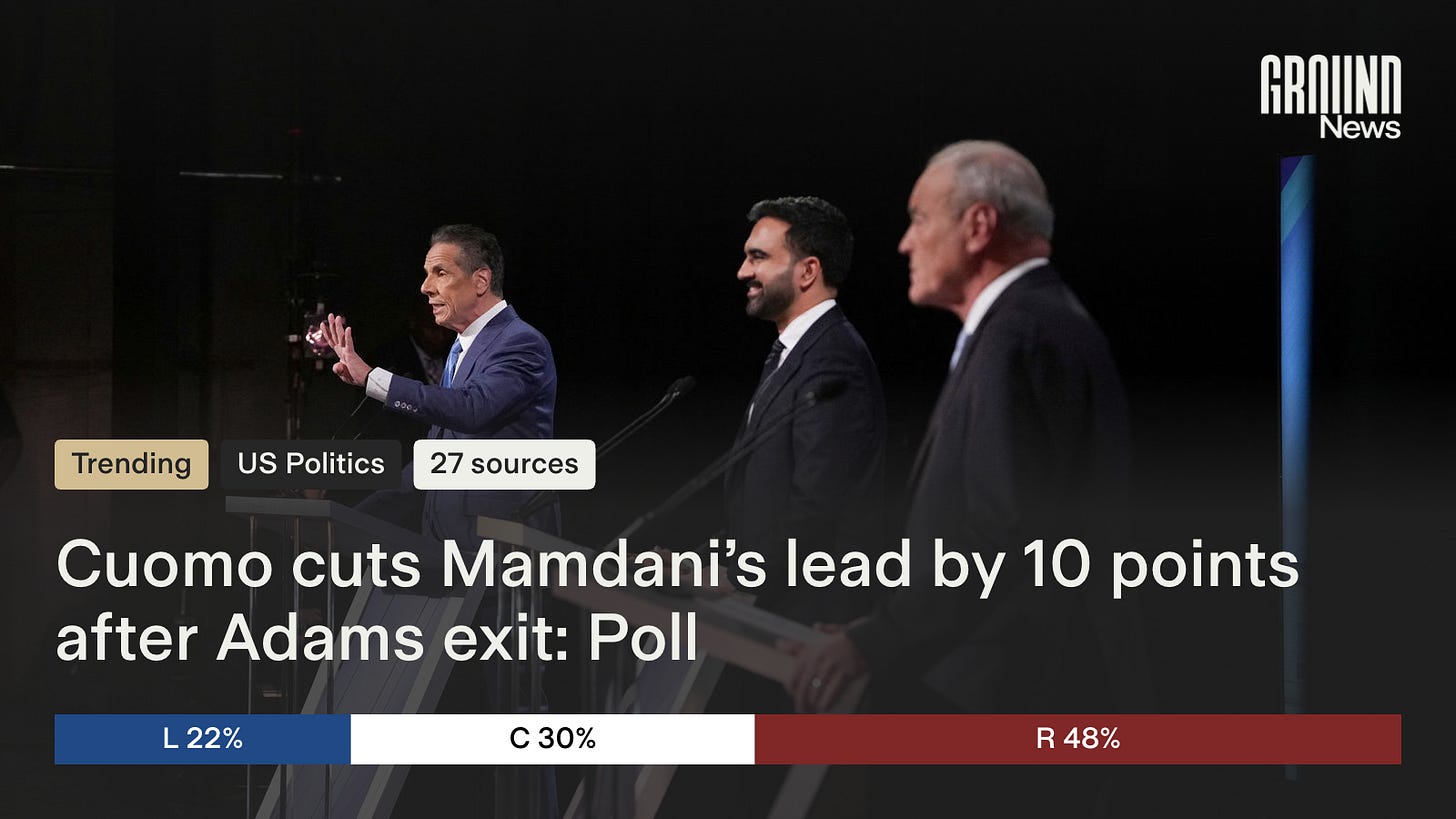
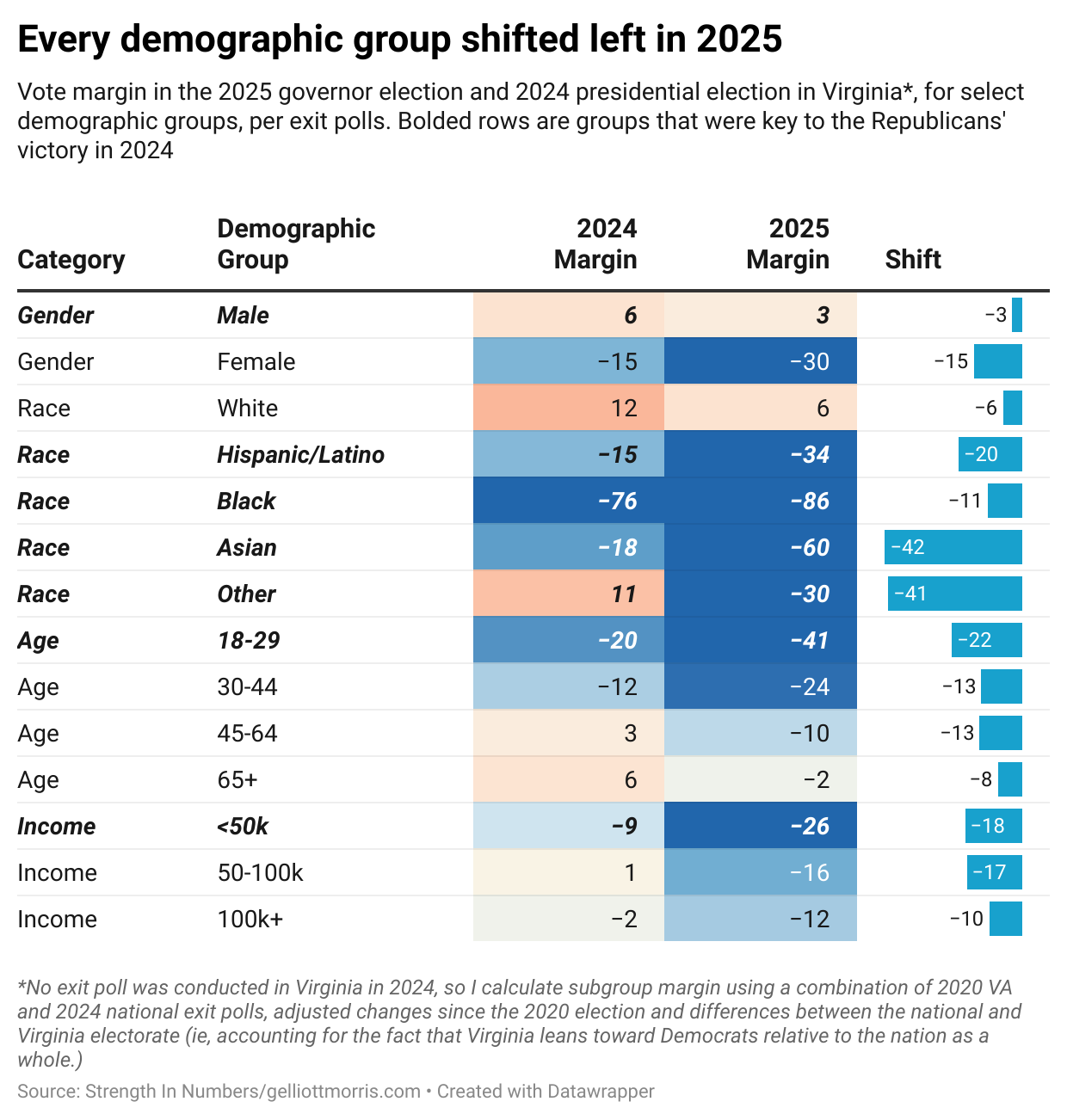



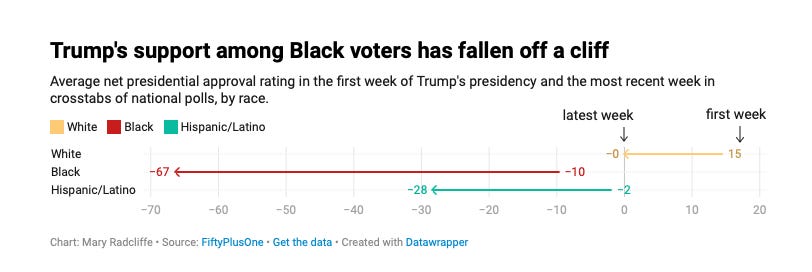
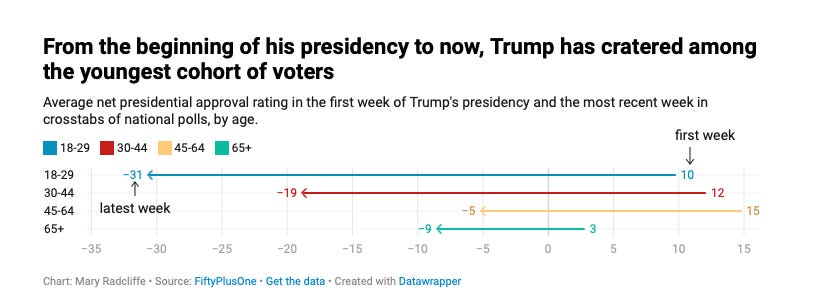
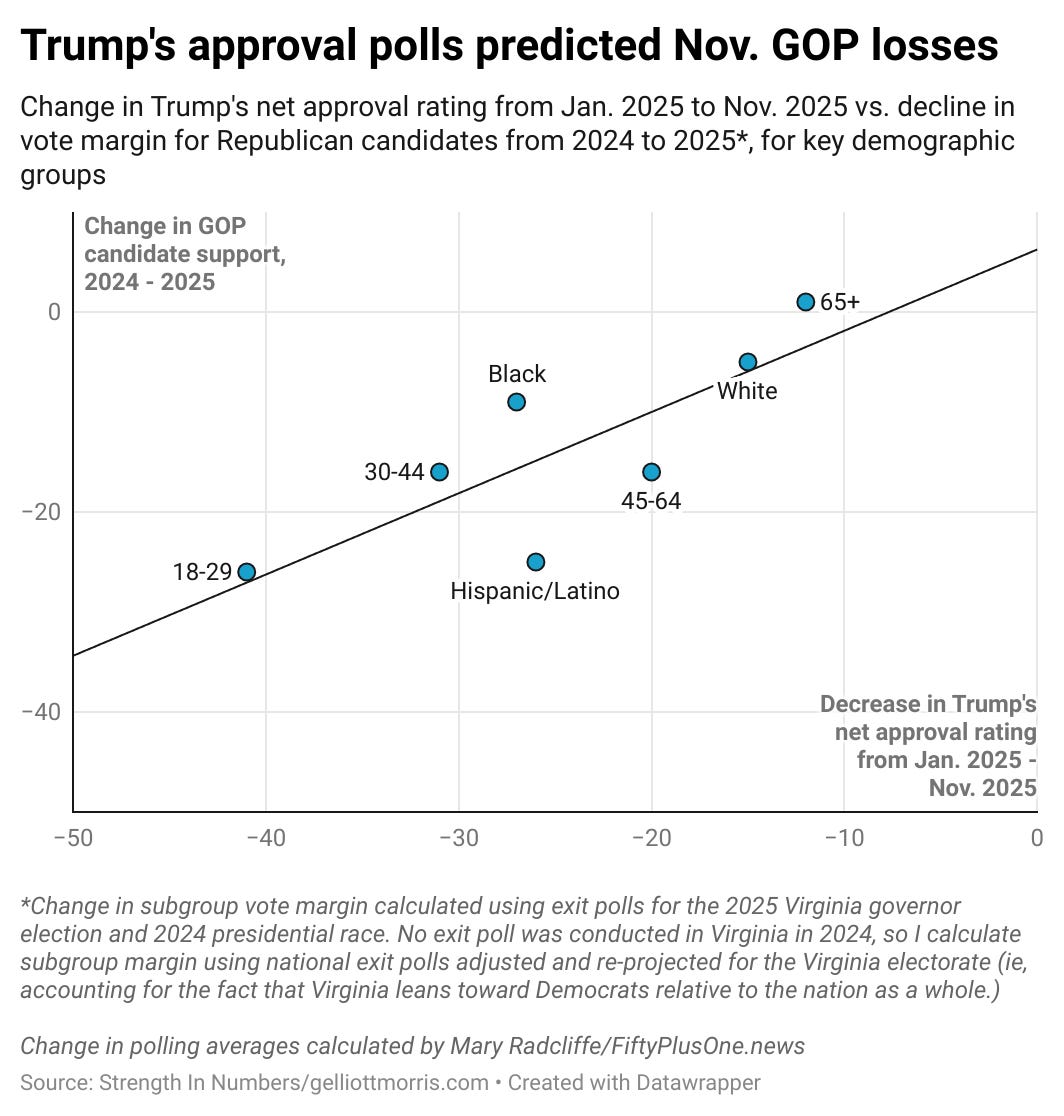


I agree people aren’t getting what they voted for, but during his campaign, Trump made no secret of his love of tariffs and ruthless immigration tactics. Perhaps it’s more accurate to say that people are getting what they have no excuse for not knowing they were voting for.
Sometimes I wonder if the frustration with "inflation" has less to do with the post-Covid inflationary episode itself, and more to do with a long-simmering cost of living crisis for which that episode provided the breaking point. I remember moving to DC from Pittsburgh in the mid-2000s and being totally floored by how expensive everything was. What of true of DC then has become true of metro areas throughout the country in the years since.